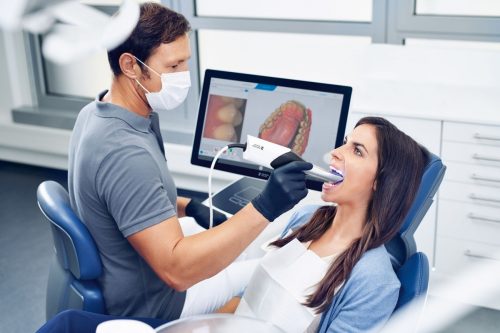Oral & Maxillofacial Surgery - Encinitas, CA
#1 Oral Surgeon in Encinitas
The word “surgery” conjures up visions of a hospital stay, general anesthesia, and a potentially long recovery period. On the other hand, oral surgery is usually a quite different experience. Oral surgery is usually performed in a dental office setting, under local anaesthesia, and with minimal recovery time. The procedures performed in oral surgery range from simple tooth extractions and implant placement to more complex jaw realignment surgeries and emergency face trauma care.
Oral and maxillofacial surgeons are specialists with advanced training and expertise in the diagnosis and treatment of various head and neck conditions and injuries. After four years of dental school, an oral and maxillofacial surgeon completes four to six years of additional formal training in treating the craniomaxillofacial complex. This specialty is one of 9 dental specialties recognized internationally and by the American Dental Association (ADA).
Oral Surgery Procedures
Prior to oral surgery, X-rays are usually taken to aid in diagnosis and treatment planning. You will be given a detailed explanation of the procedure as well as your anesthesia alternatives, and you should feel free to ask any questions you may have. The procedure you’re having and your overall health will influence how long you’ll be out of commission. Any medications you’re taking, whether prescription or over-the-counter, any chronic health conditions you have, and if you smoke should all be disclosed to your doctor. This will help to ensure your safety and comfort, which are always the most important considerations.
An oral and maxillofacial surgeon can diagnose and treat a wide variety conditions. The following are just some of the many conditions, treatments and procedures oral and maxillofacial surgeon deal with on a daily basis:
- TMJ, Facial Pain, & Facial Reconstruction
- Dental Implants
- Tooth Extractions & Impacted Teeth
- Wisdom Teeth
- Misaligned Jaws
- Cleft Lip & Palate
- Apicoectomy
- Oral Cancers , Tumors, Cysts, & Biopsies
- Sleep Apnea
- Facial Cosmetic Surgery
Whether your dentist refers you to our office, you have pain or symptoms causing you concern, or you simply have questions you would like answered, please contact our office today to schedule an appointment. We are here to answer your questions and provide the treatment you deserve!
Top-Rated Oral Surgeon in Encinitas, CA - Affordable Oral Surgeon Near Me - Encinitas Oral & Maxillofacial Surgery
Bone grafting is often closely associated with dental restorations such as bridge work and dental implants. In the majority of cases, the success of a restoration procedure can hinge on the height, depth, and width of the jawbone at the implant site. When the jawbone has receded or sustained significant damage, the implant(s) cannot be supported on this unstable foundation and bone grafting is usually recommended for the ensuing restoration.
There are several major factors that affect jaw bone volume:
- Periodontal Disease – Periodontal disease can affect and permanently damage the jaw bone that supports the teeth. Affected areas progressively worsen until the teeth become unstable.
- Tooth Extraction – Studies have shown that patients who have experienced a tooth extraction subsequently lose 40-60% of the bone surrounding the extraction site during the following three years. Loss of bone results in what is called a “bone defect”.
- Injuries and Infections – Dental injuries and other physical injuries resulting from a blow to the jaw can cause the bone to recede. Infections can also cause the jaw bone to recede in a similar way.
Reasons For Bone Grafts:
Bone grafting is a highly successful procedure in most cases. It is also a preferable alternative to having missing teeth, diseased teeth, or tooth deformities. Bone grafting can increase the height or width of the jawbone and fill in voids and defects in the bone.
There are essentially two basic ways in which bone grafting can positively impact the health and stability of the teeth:
Jaw Stabilization – Bone grafting stabilizes and helps restore the jaw foundation for restorative or implant surgery. Deformities can also be corrected and the restructuring of the bone can provide added support.
Preservation – Bone grafting can be used to limit or prevent bone recession following a tooth extraction, periodontal disease, or other invasive processes.
Oral Examinations:
Initially, the dentist will thoroughly examine the affected area in order to assess the general condition of the teeth and gums. If periodontal disease is present or the adjacent teeth are in poor condition, these factors will be fully addressed before the bone grafting procedure can begin. The dentist will also recommend panoramic x-rays in order to assess the precise depth and width of the existing bone. On occasion, a CAT scan may be recommended to determine the bone condition. Depending on these results, the dentist may also anesthetize the area and explore into the gum in order to determine what kind and how much bone is required.
What Does Bone Grafting Involve?
There are several types of bone grafts. Your dentist will determine the best type for your particular condition.
Autogenous Bone Graft – Harvested from the patient’s own body (usually from the posterior part of the lower jaw or the chin). This method is usually preferred because it produces the most predictable results.
Allograft Bone Graft – Cadaver or synthetic bone is used in this type of graft.
Xenograft – Cow bone is used in this type of graft.
The bone grafting procedure can often take several months to complete. Bone is typically harvested from your own body (or on rare occasions obtained from a “bone bank”) and added to the affected site. This bone will fuse with the existing bone and the migration of cells will cause firm adhesion and cell growth. Supplementing the jaw with bone will result in greater bone mass to help support and anchor the implant(s).
During the surgery, the dentist will numb the grafting and extraction sites using local anesthetic. A small incision will be made to prepare the site for the new bone and it will be anchored into place. On occasion, a synthetic membrane may be used to cover the new bone. This membrane prevents soft tissue and bacterial invasions, and encourages new bone growth. The surgery does not require an overnight stay, and you will be provided with comprehensive instructions for your post-operative care. The dentist will prescribe medications to help manage infection, discomfort and swelling.
Orthognathic surgery refers to the surgical correction needed to fix substantial abnormalities of the maxilla (upper jaw), the mandible (lower jaw), or both. The abnormality may be a birth defect, a growth defect, or the result of traumatic injuries to the jaw area.
Orthognathic surgery is generally performed by an oral and maxillofacial surgeon to correct malocclusion (bad bite) in cases where routine orthodontic treatment has not or will not be effective. Orthognathic surgeries include the reconstruction of the mandible or maxilla, mandibular ramus, maxilla osteotomy, and mandibular osteotomy.
There are several classifications of malocclusion (the improper coming together of teeth) which may require orthognathic surgery:
Class I Occlusion – This malocclusion means that the lower anterior incisors sit directly behind the upper anterior incisors when the patient bites down. This is considered less destructive than Class II and Class III malocclusions.
Class II Malocclusion – This is identified when the lower anterior incisors lie significantly behind the upper anterior incisors during the biting process, in some cases hitting the soft tissue behind the upper incisors. This is commonly referred to as an overbite and can cause discomfort, bone damage, excessive wear of the front teeth, and tooth loss.
Class III Malocclusion – This is commonly known as an underbite and occurs when the lower anterior incisors and lower jaw are positioned beyond the upper teeth, making the lower jaw much more prominent than the upper jaw.
Reasons for orthognathic surgery
The malocclusion of the teeth can create greatly destructive forces among the five powerful muscles that control the closing and opening of the jaw. These muscles generate a tremendous force when clenching, grinding or chewing. Misalignment can seriously damage the function and aesthetic appearance of the teeth in many ways if left untreated, such as:
- Tooth Wear – In the case of an overbite, the pressure and wear on the teeth is not spread evenly. This can also lead to TMJ, migraine headaches, and tooth loss.
- Chronic Jaw, Muscle Pain & Headache – The misalignment of the teeth alters the way the facial muscles interact. In some cases, the meniscus cartilage, which acts as a buffer between the jawbones, can be painfully damaged.
- Loose Teeth – When uneven pressure is continually exerted in unintended places or soft tissue is damaged by an overbite, adjacent teeth may become loose in their sockets which causes pain and reduces proper function.
- Tooth Sensitivity – As teeth become damaged by constant use, the enamel becomes thinner and the nerves are less protected. This lack of protection can lead to sharp pains when hot or cold foods are eaten.
- Difficulty Swallowing, Chewing, or Biting Food – Each can be associated with muscle pain and/or poor alignment of the upper and lower jaws.
What does orthognathic surgery involve?
When the dentist identifies a patient as a candidate for orthognathic surgery, a complete photographic analysis is initially undertaken. This includes panorex x-rays, cephalometric x-rays, models, impressions, and radiographs. Your oral & maxillofacial surgeon, your orthodontist and your dentist will work together and consider how the corrective surgery will impact both proper jaw function and the aesthetic appearance of the entire face.
Generally, orthodontic braces are necessary to align the arches and straighten the teeth prior to the surgery, and additionally, retainers may be used after the surgery. During maxillary surgery, the upper jaw is moved and may be secured in position using tiny plates, wires, rubber bands and screws. Surgery on the mandible is performed using bone grafts to align the lower jaw into the correct position. Orthognathic surgery generally requires a general anesthesia and a good deal of aftercare. Pain medication will be prescribed as necessary, and you’ll be given post treatment advice for your recovery. You may also be provided with a modified diet (if required).
Humans have two upper (maxillary) canines and two lower (mandibular) canines. Canine teeth are sometimes referred to as cuspids, fangs, or “eye teeth” because of their direct positioning beneath the eyes. Canine teeth have thicker and more conical roots than incisors and thus have an especially firm connection to the jaw. Canine teeth often have the longest root of all teeth in the human mouth and are the last to fully erupt and fall into place, often around age 13.
An impacted tooth essentially means that it is blocked, stuck, or unable to fully erupt and function properly. Third molars (wisdom teeth) most commonly fall victim to impaction, but the upper canine is the second most common tooth to become impacted. Wisdom teeth serve no important function in the mouth and are frequently removed; however, impacted canines are a critical condition and require treatment for the following reasons:
- Closing Gaps – Canines are the last of the front teeth to fall into place and therefore close any unsightly gaps between the other upper teeth.
First Touch – Canines play a vital role in the “biting” mechanism of the teeth. They touch first when the jaw closes, and guide the other teeth into position.- Proper Alignment & Function – Canine teeth are essential to the correct alignment and function of the other teeth on the dental arch. Missing or impacted canines can greatly affect the function and aesthetic appearance of the smile.
What causes canine teeth to become impacted?
There are several main causes for impacted canine teeth:
Extra Teeth – If extra teeth are present, the natural eruption of the canine teeth may be inhibited. The eruption progress of the canine may be directly blocked by an extra tooth or the subsequent overcrowding might leave no room on the dental arch for the canine.
Overcrowding – In some cases, poor alignment of the front teeth can lead to overcrowding. The existing teeth compete for space which means that the canines do not have sufficient room to become functional.
Unusual Growths – On rare occasions, unusual growths on the soft tissue of the gums can restrict the progress of canine teeth, which leads to later impaction.
Early and thorough examination of the teeth can pre-empt problems with impacted canines. It is important for the dentist to document the number teeth present when the patient is around 7 years of age in order to record the presence or absence of canine teeth. The older the patient becomes, the less likely it is that an impacted canine tooth will erupt naturally. If canine teeth are missing or very slow in fully erupting, the dentist can make recommendations for proper treatment.
Oral Examinations:
The dentist initially conducts a thorough visual examination of the teeth, accompanied by a panorex x-ray and/or individual x-rays. Once the cause of the impaction has been determined, there will be several treatment options available depending upon the age of the patient. The objective is to aid the eruption of the impacted canines, and this can be skillfully done by the dentist, an oral surgeon, or an orthodontist.
What does the treatment of impacted canines involve?
If your mouth is overcrowded for any reason, the dentist may recommend extraction of teeth. The extraction will generally be performed under local anesthetic by an oral surgeon. The un-erupted canine will then be exposed by lifting the gum, and guided into place using a special bracket.
In the case of younger patients, an orthodontic brace may be fitted to create a space on the dental arch for the impacted canine. Surgery for impacted canines usually does not require an overnight stay. Pain medication will be prescribed as necessary, and you’ll be given post treatment advice for your recovery.
Third molars, commonly referred to as wisdom teeth, are usually the last four of 32 teeth to erupt (surface) in the mouth, generally making their appearance between the ages of 17 to 25. They are located at the back of the mouth (top and bottom), near the entrance to the throat. The term “wisdom” stems from the idea that the molars surface at a time typically associated with increased maturity or “wisdom”.
In most cases, inadequate space in the mouth does not allow the wisdom teeth to erupt properly and become fully functional. When this happens, the tooth can become impacted (stuck) in an undesirable or potentially harmful position. If left untreated, impacted wisdom teeth can contribute to infection, damage to other teeth, and possibly cysts or tumors.
There are several types, or degrees, of impaction based on the actual depth of the teeth within the jaw:
Soft Tissue Impaction: The upper portion of the tooth (the crown) has penetrated through the bone, but the gingiva (gum) is covering part or all of the tooth’s crown and has not positioned properly around the tooth. Because it is difficult to keep the area clean, food can become trapped below the gum and cause an infection and/or tooth decay, resulting in pain and swelling.
Partial Bony Impaction: The tooth has partially erupted, but a portion of the crown remains submerged below the gum and surrounding jawbone. Again, because it is difficult to keep the area clean, infection will commonly occur.
Complete Bony Impaction: The tooth is completely encased by jawbone. This will require more complex removal techniques.
Reasons to remove wisdom teeth
While not all wisdom teeth require removal, wisdom teeth extractions are most often performed because of an active problem such as pain, swelling, decay or infection, or as a preventative measure to avoid serious problems in the future. If impaction of one or more wisdom teeth is present, and left untreated, a number of potentially harmful outcomes can occur, including:
- Damage to nearby teeth: Second molars (the teeth directly in front of the wisdom teeth) can be adversely affected by impacted wisdom teeth, resulting in tooth decay (cavities), periodontal disease (gum disease) and possible bone loss.
- Disease: Although uncommon, cysts and tumors can occur in the areas surrounding impacted wisdom teeth.
- Infection: Bacteria and food can become trapped under the gum tissue, resulting in an infection. The infection can cause considerable pain and danger.
- Tooth Crowding: It has been theorized that impacted wisdom teeth can put pressure on other teeth and cause them to become misaligned (crowded or twisted). This theory isn’t universally accepted by all dental professionals, and it has never been validated by any scientific studies.
Wisdom teeth examination
As with any dental procedure, your dentist will want to initially conduct a thorough examination of the wisdom and surrounding teeth. Panoramic or digital x-rays will be taken in order for your dentist to evaluate the position of the wisdom teeth and determine if a current problem exists, or the likelihood of any potential future problems. The x-rays can also expose additional risk factors, such as deterioration or decay of nearby teeth. Early evaluation and treatment (typically in the mid-teen years) is recommended in order to identify potential problems and to improve the results for patients requiring wisdom teeth extractions. Only after a thorough examination can your dentist provide you with the best options for your particular case.
What does the removal of wisdom teeth involve?
Wisdom teeth removal is a common procedure, generally performed under local anesthesia, intravenous (IV) sedation, or general anesthesia by a specially trained dentist in an office surgery suite. The surgery does not require an overnight stay, and you will be released with post-operative instructions and medication (if necessary), to help manage any swelling or discomfort.
There are a number of reasons that your dentist might recommend a tooth extraction. Some dental patients suffer from tooth decay; others need to remove teeth hindering orthodontic treatment, whereas various patients simply need wisdom teeth removal. While a tooth extraction can be a serious dental procedure, aftercare is just as critical as the procedure itself. As the dental patient, it is important to understand that pain and the risk of infection can be lessened with proper care.
Care immediately following surgery:
- Keep pressure on the gauze pad that your doctor placed over the surgical area by gently biting down. Dampen the gauze sponge with water if it begins to dry out. Try to maintain constant pressure in intervals of 45-60 minutes, repeating as often as needed, or until bleeding lessens. Change the gauze as needed.
- Keep your head elevated and try to lower your activity level as much as possible.
- 48 hours after surgery, rinse mouth with warm salt water every 1-2 hours. Avoid using any mouthwash containing alcohol as it can irritate the wound.
- Keep your mouth clean by brushing areas around the surgical site, but be sure to avoid sutures. Touching the wounded area in any fashion should be prevented.
- Use ice packs to control swelling by placing them on facial areas near extraction.
- Take all prescribed medications accordingly. If any itching or swelling occurs, contact the practice immediately, or go to the nearest emergency room.
- Try to eat softer foods, preferably high in protein.
- Keep your body hydrated by drinking plenty of fluids, but do not drink through a straw for the next 5-7 days.
- If you are a regular tobacco user refrain from smoking for the next 3-4 days as smoking increases your chances of getting a dry socket as well as an infection.
After your tooth has been extracted, healing will take some time. Within 3 to 14 days, your sutures should fall out or dissolve. For sutures that are non-resorbable, your doctor will schedule a follow-up appointment to remove the stitches for you. Your tooth’s empty socket will gradually fill in with bone over time and smooth over with adjacent tissues.
It’s important to note that there are some possible complications that can occur after a tooth extraction:
Bleeding – Bleeding after a tooth extraction is entirely normal. A pinkish tinted saliva and subtle oozing is fairly common during the first 36 hours. If bleeding gets excessive, control it by using dampened gauze pads and biting down to keep pressure on the area. As an alternative to gauze pads, a moistened tea bag can be used, as the tannic acid helps blood vessels contract. Apply pressure to the gauze or tea bag by gently biting down for 30 minutes. Please remember that raised tempers, sitting upright, and exercise can all increase blood flow to the head, which can cause excess bleeding. Try to avoid these as much as possible. If your bleeding does not reduce after 48 hours, please call the practice.
Bone sequestra (dead tooth fragments) – Some patients have small sharp tooth fragments that were unable to be completely removed during surgery. During the recovery period, these dead bone fragments, or bone sequestra, slowly work themselves through the gums as a natural healing process. This can be a little painful until the sequestra are removed so please call our practice immediately if you notice any sharp fragments poking through the surgery site.
Dry socket – In the days that follow your tooth extraction, pain should gradually subside. Rarely, patients report that pain increases to a throbbing unbearable pain that shoots up towards the ear. Often this is a case of dry socket. Dry socket occurs when the blood clot becomes irritated and ousted before healing is complete. Food and debris can then get into the socket causing irritation. Tobacco users and women taking oral contraceptives are at a higher risk of getting dry socket. Dry socket is not an infection but does require a visit to our office. If you think you may be suffering from dry socket, please contact the practice immediately.
Lightheadedness – Because you may have been fasting prior to surgery, your blood sugar levels may be lower than normal. Until your body has had the chance to catch up and process some sugars, you should remember to stand up slowly when getting up from a relaxed position. For somewhat immediate relief, try eating something soft and sugary, stay in a relaxed position, and reduce the elevation of your head.
Numbness – Many patients report still feeling numb hours after their tooth extraction procedure. An extended lack of feeling around the mouth is normal and can last 10-12 hours after surgery.
Swelling – Swelling should subside almost entirely within 10 days after surgery. Immediately following your tooth extraction, apply an ice pack to the facial areas near the extraction. Continue using the ice in 15 minute intervals for the first 36 hours. After 36 hours, ice will no longer be beneficial in reducing swelling and moist heat should be used instead. To decrease swelling, apply a warm damp cloth to the sides of your face.
Trismus (difficulty opening and closing mouth) – If you experience a sore jaw and difficulty chewing or swallowing, do not be alarmed. Occasionally patients’ chewing muscles and jaw joints remain sore 3-5 days after surgery. This soreness can also make it difficult to open and close your mouth. Soreness should eventually subside.
If you have any worries, or are experiencing any complications not mentioned, please contact our practice immediately so that we may address your concerns.
Following dental implant surgery, patients must take detailed care of the area surrounding their new implant. For the first month the dental implant is still integrating with the bone and tissues so the patient’s care routine will be slightly more involved during this initial period. Above all, do not disturb the wound in the initial days that follow surgery. Avoid rinsing, spitting, and touching the mouth for 24 hours after surgery to avoid contaminating or irritating the surgical site. After dental implant surgery it’s important to follow these care instructions:
- Antibiotics – Patients should take all prescribed antibiotics to prevent infection at the surgical site. Twenty-four hours after the surgery, patients should begin using the prescribed oral rinse twice daily alongside a warm saltwater rinse 4-5 times daily (preferably after every meal/snack).
- Bleeding – Blood in the patients’ saliva is normal during the first 24 hours following surgery. We suggest biting on gauze pads to help control and lessen blood flow. Gently bite down on the gauze pad and try to maintain constant pressure, repeating as often as needed, or until bleeding lessens.
- Dealing with pain – Shortly after your dental implant surgery the anesthetic will wear off. You should begin taking pain medication before this happens. Any over-the-counter pain medication can be taken (e.g., Tylenol®, Aleve®, ibuprofen, etc.).
- Diet – We recommend an initial diet of soft foods, but patients can resume a normal diet as soon as they feel capable of doing so. Stay hydrated. It is critical that you are drinking plenty of fluids.
- Hygiene – In order for the dental implants to heal properly, the surgical site must be kept clean. Continue to brush your teeth as you normally would, but avoid any sutures and do not brush the implant. The antibiotic and saltwater rinses will disinfect the implant itself.
- Swelling – After dental implant surgery some amount of swelling is to be expected. To help minimize swelling, try to keep your head elevated and lower your activity level as much as possible. Use ice packs for the first 48 hours and apply continuously, or as frequently as possible to minimize facial swelling.
- Wearing your prosthesis or night guard – Partial dentures, flippers, full dentures, retainers, or night guards should not be used for at least 10 days following surgery. If there are any special circumstances, our practice will discuss those with you during your pre-operative consultation.
- Smoking – Smoking after dental implant surgery has an increased risk of infection which also increases the risk of dental implants failing to integrate. We recommend that patients do not smoke for a minimum of 2 weeks after dental implant surgery.
What does recovery involve?
While each patient’s case is different, recovery after dental implant surgery happens in a series of phases. With your new dental implants, maintaining proper oral hygiene should be your primary focus. In order for the implant to properly fuse with the jawbone, it must remain clean. Also keep in mind that when properly cared for, a dental implant can serve its owner for life.
When maintaining proper hygiene, oral discomfort should gradually lessen. Swelling, bruising, and minor bleeding may still occur. If any pain does continue, feel free to continue using the pain medications.
Healing time differs depending on whether a patient receives immediate crown placement, or waits for the implant to fuse with the jawbone. Your recovery timeframe will depend on your individual case and treatment plan; follow-up appointments will be scheduled accordingly.
If you have any questions, please feel free to contact our office.
Meet Your Doctors
Patient Reviews




We Love your Dental Insurance!



















